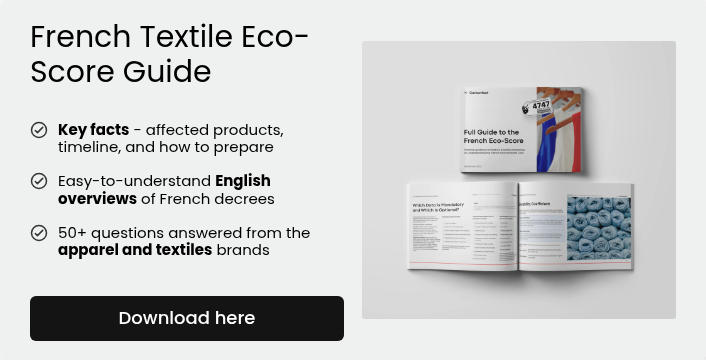Status: Proposal stage
Across Europe, textile labeling regulations are entering a new phase. France has already implemented its “Environmental Cost” label, and Germany operates the state-backed Green Button. Italy is now preparing to follow suit with its proposed “Sistema Nazionale di Eco Score Tessile (SNET)” – a national Eco-Score system designed to classify textile products according to environmental impact and address the rapid growth of ultra-fast-fashion through penalties. Find the original legislation proposal text here (in Italian).
This move is not happening in isolation. It aligns with the broader EU regulatory trajectory: stronger Extended Producer Responsibility (EPR) schemes, upcoming ecodesign requirements, and increasing demand for product-level environmental data. Italy’s proposal brings these themes together by combining environmental scoring, targeted taxes, advertising restrictions, and EPR into one framework.
If your brand is selling in Italy, this bill should be on your radar. It is still under discussion in the Italian Senate, but it offers a clear signal of where national regulation is heading: fashion brands with better product impact data and alignment with EU regulations, such as Digital Product Passport (DPP), will be rewarded with more market access and financial incentives.
Let’s dive in!
TL;DR
Italy’s new draft law targets ultra-fast-fashion with three main measures:
-
Eco-Score system (SNET): An A–E scoring system for textile products used by the government to decide which companies to punish and which to reward for environmental performance.
-
Advertising ban: From January 1, 2026, ads for ultra-fast-fashion are proposed to be banned, including influencer promotions.
-
Parcel eco-tax: A €2–4 tax on small parcels (<2 kg) with textile products shipped from outside the EU.
Inside Italy’s New Fast-Fashion Bill
Bill DDL S. 1690 was introduced in the Italian Senate in October 2025. It bundles several measures into one law, all aimed at curbing the environmental impacts of ultra-fast-fashion and protecting Italy’s domestic textile industry from the competitive pressures of low-cost, high-volume products. Some of these measures – such as the advertising ban and the parcel eco-tax – can be enforced as soon as the bill becomes law, because they target a clearly defined group of brands (see how ultra-fast-fashion is defined by the bill in the next chapter).
Other measures – including the per-kg environmental contributions and restrictions linked to tax benefits – depend on the Eco-Score system SNET. These measures can only begin once the government publishes the technical scoring rules that define how products will be evaluated under the SNET.
Definition of Fast-Fashion and Ultra-Fast-Fashion
To understand which companies will be affected by the proposed measures, the bill provides explicit definitions of “rapidly renewing fashion” and “ultra-fast-fashion.” These definitions are important because even before the Eco-Score system is finalized, the government can identify ultra-fast-fashion brands and already take targeted measures against them.
Rapidly renewing fashion – Industrial and commercial practices aimed at constantly introducing a high volume of new clothing items in extremely short timeframes, driving impulsive consumption and rapid product turnover.
Ultra fast-fashion – A rapidly renewing fashion model characterized by:
- Introducing more than 5,000 new items per month, including through digital channels.
- Operating without seasonal collections and with product turnover under 30 days.
- Using production models that do not comply with international environmental and social standards.
- Lacking traceability, sustainability certifications, or digital identification tools such as the Digital Product Passport.
- Relying heavily on low-quality, short-lived synthetic materials that are difficult to recycle.
- Having no structured end-of-life strategy, such as take-back, repair, or recycling programs.
- Not incentivizing garment reuse or maintenance.
- Receiving an Eco-Score classification of D or E (once the scoring system is operational).
The bill explicitly highlights platforms such as Temu and Shein as examples of the ultra-fast-fashion model it seeks to regulate.
Now, let’s deep-dive into the proposed measures.
SNET: Italy’s Eco-Score Proposal for Textile
Sistema Nazionale di Eco Score Tessile (SNET) is Italy’s proposed national A–E environmental scoring system for textiles. Unlike the French Eco-Score label, Italy’s Eco-Score is not designed as a consumer-facing label. Instead, the government uses the scores internally to classify textile products according to environmental performance and decide which rules apply to them – such as taxes, advertising restrictions, or access to financial incentives. Think of it as a classification tool for the government, so they know which companies to punish and which to reward for environmental performance.
Here is what we know so far:
- Scoring: A (lowest impact) to E (highest impact). We lay out the preliminary evaluation criteria below; however, the concrete data points have not yet been defined by the bill.
- Scope: All brands selling in Italy will be affected. Regardless of company size, the brand will be attributed a score based on environmental performance.
- Product categories: All textiles placed on the Italian market are expected to be affected. Note: the official document does not yet clarify whether footwear and accessories will be excluded, as in the French Eco-Score.
- Timeline:
- The proposal is currently in the Senate committee review stage, where lawmakers can analyze and amend the text.
- After this phase, it must be approved by the full Senate and then by the Chamber of Deputies.
- Only once both chambers agree on the final version will the law be published. It would then take effect 60 days later.
- Afterwards, within the following 90 days, the government must issue technical decrees that define how the Eco-Score will be calculated, how data must be provided, and who performs the scoring.
- The Eco-Score system can only begin operating once these technical rules are published.
We will keep you updated!
SNET: Textile Product Scoring Criteria
The system assigns each product an environmental score ranging from A, corresponding to the least impact, to E, corresponding to the most impact, based on the following parameters:
- production conditions and location
- origin, quality, and composition of materials
- logistics and distribution methods
- durability and repairability of garments
- working conditions
- and compliance with social requirements in the supply chain
Note: The official documentation does not yet specify the source of this data. For context, the French Eco-Score uses two types of data: mandatory parameters (product category, mass, raw-material composition, and the manufacturing locations for textile formation, finishing, and assembly) and optional parameters (such as transport mode, sourcing origins, durability features, or repair-service offerings). When optional data is not provided, the system automatically applies conservative defaults, such as “India” as the manufacturing country or 100% air transport. Read all about it in our deep French Textile Eco-Score deep-dive here.
The Italian government indicated that companies can be granted a favorable Eco-Score classification (A, B, or C) if they can demonstrate the following:
- adoption of production traceability systems
- possession of environmental and social certifications recognized at the European or international level
- compliance with the obligations arising from the principle of extended producer responsibility (EPR)
- implementation of the Digital Product Passport, where required by European legislation
Note: These requirements are crucial in avoiding the further outlined penalties and market restrictions. Start preparing your product environmental data now to avoid losing a competitive advantage later.
SNET: Fast-Fashion Penalties
Under the SNET, products falling into classes D and E, those assessed as higher impact, would face a set of requirements and restrictions. Here are the expected penalties:
Environmental Communication Obligations
Fast-fashion and ultra-fast-fashion brands selling products online will be required to display two pieces of information directly next to the selling price:
- Clear and contextualized environmental responsibility messages that encourage responsible consumption, reuse, repair, or recycling.
- The geographical origin of manufacturing, shown in text that is the same size and visibility as the price itself.
These messages must be clear, proportionate, and not misleading for the consumer. Technical methods for the application of this measure, including the thresholds, information content, and exemption criteria, are yet to be defined.
Extended Producer Responsibility
While Italy finalizes a broader Extended Producer Responsibility (EPR) system for textiles, brands in Eco-Score classes D and E would pay:
- €0.30/kg for class D
- €0.50/kg for class E
This contribution applies to sales through all channels, including non-Italian e-commerce platforms shipping into Italy. Foreign brands must appoint an Italian tax representative who shares responsibility for all EPR reporting, payments, and compliance obligations.
Methods for calculating, declaring, paying, and reporting the contribution, as well as the traceability and control systems, and the sanctions for non-compliance, are yet to be defined.
Loss of Tax Benefits
The bill removes access to existing tax benefits for brands operating fast-fashion or ultra-fast-fashion business models. Specifically, these operators will no longer qualify for the tax relief granted under Italy’s income tax code for the free donation of unsold goods to charities or other eligible recipients.
What is Carbonfact's Approach?
Sustainability reporting platform for Apparel & Footwear:
- Production Traceability Systems: Carbonfact provides material-level tracking that links each product's Bill of Materials (BOM) to supplier and factory data. Carbonfact integrates with existing traceability tools like FairlyMade and Retraced, so you can work alongside these systems rather than replacing them. For example, we retrieve data directly from FairlyMade for brands like A.P.C.
- Environmental Certifications: Carbonfact tracks and displays certification data (such as GOTS, OEKO-TEX, organic, and fair trade labels) as part of product information. This data can be included in product pages, Digital Product Passports, and environmental reporting.
- Link Product and Sales Data: Our platform connects your product specifications – including detailed fiber compositions and component weights – with sales data, ensuring accurate and complete EPR reporting.
- DPP Solution: Carbonfact automates Digital Product Passport creation by transforming your product LCA data into shareable pages (with QR codes) that display environmental footprint, material composition, and traceability information.
Apart from penalties coming from the SNET scoring system, here are the additional separate measures proposed by the bill:
Advertising Restrictions for Fast-Fashion Brands
This measure operates independently from the Eco-Score system and does not rely on SNET to be enforced. If the bill is approved, the advertising restrictions would begin on 1 January 2026, regardless of whether the Eco-Score methodology is finalized. From this date, brands would be prohibited from any direct or indirect advertising that promotes fast-fashion or ultra-fast-fashion business models. This applies across all channels, including traditional media, digital advertising, marketplace listings, influencer content, and creator promotions.
The measure also restricts the use of terms such as “free” when they encourage impulsive or unlimited purchasing. The term may only be used in communications promoting circular practices – such as repair, reuse, take-back, or recycling – or when it is not tied to the sale of new products.
Financial penalty: Violations of these rules would be subject to administrative fines of up to €100,000, enforced by the Italian Competition and Market Authority (AGCM), including cases reported by public bodies or consumer organisations. How the ban should be applied in practice is yet to be defined.
Tax on Small Non-EU Parcels
A new “eco tax” of €2–4 per parcel is considered on packages under 2 kg containing textile products shipped from non-EU countries into Italy. This is designed to penalize fashion business models built on huge volumes of cheap, small parcels from outside the EU.
Customs Traceability
The bill also requires the government to develop new customs and traceability measures for non-EU textile imports. Within six months after the law enters into force, the government must present proposals to strengthen transparency at the border and shift the burden of proof to exporters – meaning non-EU suppliers may be required to provide more detailed information about origin, materials, and production conditions as part of customs procedures.
Fashion Regulations: EU Policy Context
To understand why Italy is moving toward a national Eco-Score, it is also useful to look at the broader regulatory developments taking shape across the European Union.
Extended Producer Responsibility Schemes
Across the EU, apparel and footwear regulations are evolving, driven by new requirements on circularity and environmental performance. Countries are rolling out textile Extended Producer Responsibility (EPR) schemes, and the upcoming revision of the Waste Framework Directive (WFD) will push these schemes toward a more harmonised EU-wide approach. The political and technical work is still ongoing, with the overall framework expected to land around mid-2027, but the direction is already clear: products that generate more waste will increasingly pay more.
Ecodesign for Sustainable Products Regulation
In parallel, the EU’s Ecodesign for Sustainable Products Regulation (ESPR) is setting the stage for a future where every product has to meet minimum performance requirements on durability, repairability, and recyclability. ESPR is also where the EU could eventually align member states behind a single environmental performance label for consumers. Again, the road to full implementation runs to roughly 2027, but preparation has already started.
A key milestone in this preparation is the development of the Product Environmental Footprint Category Rules (PEFCR) for textiles. After five years of development, PEFCR now provides a unified, science-based method to measure product-level environmental impacts. This method is expected to inform future ecodesign parameters, eco-modulated EPR fees, and national environmental labelling schemes in the EU.
Eco-Score
On the national level, governments are not waiting. They are already introducing anti–fast-fashion laws to both prepare for EU requirements and protect local industries:
- France led the way with the AGEC Law, the Climate Law, and, most recently, a dedicated fast-fashion law that introduces eco-taxes and advertising restrictions. This October, France also became the first European country to implement the Eco-Score (Environmental Labeling) scheme for textiles.
- Germany has the Green Button (Grüner Knopf), a state label combining product criteria with company due diligence checks.
- Italy is now also moving towards a national environmental scoring system for textiles.
Prepare Your Data Now, Avoid Penalties Later
Regulations like France’s Environmental Cost label – and Italy’s proposed SNET – make one thing clear: brands will increasingly need complete, verified, and product-level environmental data to stay compliant and avoid financial penalties. Whether it’s calculating an Eco-Score, proving traceability, or differentiating between high- and low-impact products, brands that lack structured data will face higher scores, higher fees, and stricter restrictions.
This is where Carbonfact helps apparel & footwear brands. Carbonfact is the environmental data platform built specifically for the apparel and footwear industry. Measuring the environmental footprint of a product is complex – data is often scattered across suppliers, production partners, and internal teams. As regulations tighten, doing this manually becomes unsustainable.
Here is how Carbonfact already helps customers to comply with the French Eco-Score:
- Automated Eco-Score calculation for all products: Carbonfact imports all your data, generating Eco-Scores for all products in scope without manual work.
- Compare against category benchmark products: Carbonfact’s platform allows you to see how your product compares against industry averages and decide whether to publish or improve first.
- Simulate and improve your Eco-Score: Use Carbonfact’s Eco-design Tool to simulate products with differing materials and processes – so you can see and improve your score before publishing.
- Push data directly to the French declaration portal: Carbonfact is integrated with Ecobalyse, so you can submit your calculated Eco-Scores directly to the French portal.









 Lidia Lüttin
Lidia Lüttin

 Martin Daniel
Martin Daniel

 Vincent Carrières
Vincent Carrières